BLACK




We are here. Despite the whitewashed history of rural America, Black people have always existed in the Appalachian region. The Census numbers may be small, but the contributions are huge, including the introduction of the banjo by Black blues musicians in the late 1700s. Just as the instrument played a critical role in the development of modern music, Black residents play a big part in shaping the culture and the conversations of Appalachia and beyond.
The Black Appalachian Coalition (BLAC), an initiative of Blaque Women Rising, launched on June 18, 2021, to ensure accurate and inclusive accounts are being told. Led by Founder and Executive Director Bishop Marcia Dinkins, the four-state coalition works to counter the longstanding erasure of Black voices from the stories and policies in the region. In the fall of 2021, BLAC and the Ohio River Valley Institute (ORVI) hosted a series of virtual listening sessions to hear from Black Appalachians. The five sessions were part of the national conversation around infrastructure policy but the subjects weren’t limited to infrastructure. Black Appalachians shared stories about their past and present and thoughts about how the region should move forward. This document highlights some common themes across the sessions related to policymaking in Appalachia. The eight hours of rich dialogue throughout the sessions can be viewed on BLAC’s YouTube Channel.
When most people picture the Appalachian region, they don’t see Black people. Black Appalachians have been erased from the region’s history and replaced by a whitewashed image of rural America. In a region where economic prospects are grim, racism compounds the problems.
The Black Appalachian Coalition (BLAC) is working to change that. BLAC provides a platform where Black residents are seen and heard as leaders, credible messengers and experts. By changing the narrative, BLAC can begin to change the power structure of the region and confront the discriminatory practices which left Black Appalachians with fewer opportunities than their white neighbors. Through listening sessions, BLAC helped to shape how policymakers create and implement inclusive policies. Speakers identified many policy needs for Black communities in Appalachia—including increased access to healthcare, healthy foods, child and elder care, public transportation, clean air and water, quality education, jobs, higher pay, and criminal justice reform.
Across all of these areass, there is a common need for Black storytelling and participation as a precondition for policymaking. Narratives shape how policymakers prioritize public problems. Narratives that leave out the Black parts of the region’s past and present guarantee that problems experienced by Black people won’t be prioritized. Policymakers should place more value on creating spaces for groups of Appalachians that have been historically oppressed or ignored to share their stories, which will result in more accurate accounts of the region’s past and present.
In addition to policy implications, decolonizing Appalachian stories is key to helping many Black Appalachians see themselves in this place and heal individually and collectively from past racial trauma. Without this healing, prosperity for many members of Appalachian communities remains beyond reach.

“Black people are missing from the policymaking table. Participatory policymaking does not include us.”
— Bishop Marcia Dinkins, Warren, Ohio
Black Appalachians helped shape Appalachia’s society and economy, from Black workers in the coal and steel industries to midwives in the care economy. Black leaders from Appalachia also made significant contributions to regional and national social movements, from the NAACP to the black lung movement.


“The more I discovered history, the more I understood that Black people in West Virginia have had a powerful presence. But that history is not always front and center in our textbooks. It’s not always front and center in how the media frames West Virginia [and greater Applachia]”
— Crystal Good, Kanawha County, WV
“When the NAACP started, it was initiated by the Niagara Movement, which took place in Harpers Ferry, West Virginia. When the garbage workers’ strike took place in Charleston, I kind of got drawn into it, not by the NAACP, because they were not really active in that struggle, but by the union. I just remember how much fun we had just participating in that movement that was intended to deal with equal wages.”
— Akisha Townsend-Eaton, Bowling Green, KY
“When the NAACP started, it was initiated by the Niagara Movement, which took place in Harpers Ferry, West Virginia. When the garbage workers’ strike took place in Charleston, I was drawn into it, not by the NAACP, because they were not very active in that struggle, but by the union. I just remember how much fun we had participating in that movement that was intended to deal with equal wages, wages for those garbage workers.”
— Reverend Ronald English, Charleston, WV
Despite historical narratives that paint Appalachia as white, Black people comprised a significant share of the Appalachian population. In the Central Appalachian counties of Kentucky, Tennessee, Virginia, and West Virginia—the predominantly rural subregion of Appalachia often considered to have little or no racial diversity—nearly one in six people were Black in 1820. For context, that is a higher percentage than the current national Black population.(1) The relative share of Black Appalachians has since steadily and significantly decreased, however, this illustrates that even the areas of Appalachia with the smallest Black populations at present were shaped by centuries of Black contributions. Today, tens of thousands of Black people call Central Appalachia and the rural counties in Northern Appalachia their home.

 Black
Black
“My great great grandmother, who went by the name of Maime Callie, was a midwife who traveled by horseback. She was one of the most wellregarded midwives in the region, and white families needed her services out of necessity. But she was especially important to Black families, who could really only be able to have access to the services of a Black midwife. If you were to do a Google search of midwives on horseback, you would not see one single image of a Black midwife during that time.”
— Akisha Townsend-Eaton, Bowling Green, KY

When many Americans conjure up a mental image of an Appalachian coal miner or a steel mill worker in the Rust Belt, they don’t see a Black person.But, Black Appalachians were critical to the booming of these Appalachian industries and their historic contribution to the national economy.
In 1930, 1 in 11 coal miners in the states of Ohio, Pennsylvania, Kentucky, and West Virginia were Black. Nearly a quarter of West Virginia coal miners were Black in 1930.Since this era, Black employment in the coal sector has declined steadily and was 3.1% nationally in 2020. Similarly, Black workers made up a significant share of the workforce in the steel mills of the region. For example, in Western Pennsylvania, Black workers made up 13% of the region’s steelworkers in 1918.


Speakers discussed the many instances in which Black Appalachians have been erased from popular narratives about both who is Appalachian and who is deserving of the attention of policymakers.
“When we look at Appalachian communities, we do not see ourselves represented in that. There are many, many countless stories of contributions not only from Black Kentuckians, but Black Appalachians in Kentucky. And the notion is that the victor always gets to tell the story, right? And we know many times in many communities where Black individuals have not been the victor. And they have not had control of the narrative or the telling of their story.”
— Shana Goggins, Richmond, KY“When I think of West Virginia, and I think of how people think of white poverty, recognize that, inside that, not everybody is white, and that poverty impacts those people greater. So what we have to do is be visible, because we’re invisible in this narrative. I mean, how many years have we had of people telling the opioid story and not once have you heard the stories that I live with, of grandmothers and mothers who got addicted to pain pills, and that are gone now. Because, you know, nobody’s asking the question.”
— Crystal Good, Kanawha County, WV

The share of Appalachians who cannot afford basic necessities is much higher than the national average. In 2019, the Appalachian regions of Kentucky, Ohio, Pennsylvania, and West Virginia had a combined rate of 15.5% of people whose incomes fell below the federal poverty line. That number almost doubles for African Americans–30.5% of Black Appalachians could not afford basic necessities. The figure below represents 130,577 Black people in the area whose income fell below the poverty line in 2019.
The racial gaps were the largest in Pennsylvania and Ohio: the Black poverty rate was about 19 percentage points higher than the white poverty rate. The COVID-19 pandemic likely increased the poverty rates —and perhaps widened the racial gaps. It is also important to note that many analysts consider the federal poverty line an outdated measure that does not capture everyone experiencing economic distress.


Appalachia = ARC Counties of Kentucky, Ohio, Pennsylvania, and West Virginia

A consistent theme was the displacement of Black people in Appalachia and the lack of widespread understanding of this displacement. A significant wave of Black migration occurred alongside “urban renewal” projects that displaced Black Appalachian communities in the 1960s and 1970s. One such project was the interstate project that came through the Black community in the Triangle neighborhood of Charleston, Wes Virginia, in the 1970s. Local and state officials demolished the businesses and homes of a vibrant and longstanding Black community in Triangle to construct a new intersecting interstate system in downtown Charleston. As a pretense for its demolition, officials perpetuated narratives that the Triangle community was a dangerous and illicit area that needed to be “redone.” Black residents fought the project, but hundreds of families were eventually displaced.

“The road is not wanted. The Governor could, by executive order, have the road rerouted, which had been done earlier when the road was tentatively going through Kanawha City, but it was rerouted. It was rerouted to save hills around the Capitol. It’s going to be rerouted around Logan County. And if he can look out for the poor, white farmers, he can look out for the poor angry Black folk in the Triangle District,” said Emmerson Reed when speaking to a reporter in the 1970s about the West Virginia Governor and the proposed interstate project that would demolish Triangle.
Speakers in the listening sessions mentioned that their communities also experienced Black displacement and “white flight,” which was often accompanied by disinvestment of downtown areas. The case of the Triangle neighborhood is relevant for current conversations around how and where to invest infrastructure funds for several reasons. It underlines how Black Appalachians have had dramatically different and often harmful experiences with past infrastructure buildout. It also highlights that the current low relative Black population in many Appalachian areas is partly a result of policies that displaced Black residents and workers who historically shaped these places.
“In my community, what the city intends to do [regarding new federal funds] is to distribute a survey to the citizens to receive input. Now, as a behavior scientist, that absolutely intrigues me. But, also, I find it sort of problematic, in that in the distribution of the survey to solicit comments, are you making sure that this survey is widely being distributed to communities and neighborhoods or groups of people that are not typically a part of this conversation?”

— Shana Goggins, Richmond, KY





Speakers discussed the need to acknowledge and address historical and present-day racial trauma experienced by Black Appalachians and to decolonize what it means to be “Appalachian.” Revising untruthful narratives prevalent in our education, media, and policymaking that leave out the rich history of Black people in Appalachia and the racist harms experienced by Black people here is foundational to creating a place where Black Appalachians can heal—and can see themselves in the stories about their home.
From better access to Black mental health experts to teaching accurate histories about the region, decolonizing Appalachian identity and prioritizing the healing of Black Appalachian communities must be a regional priority.

“We cannot allow ourselves to be erased, in that so, many other entities and groups will try their level best to make it seem as though we are not here and we have not had an impact. We are tasked with the challenge of making sure that that does not happen.”
“I’m so thankful for the Black Appalachian Coalition, I’m so thankful for this opportunity to actually know that I have a story worth telling.”
“There are so many ways we could hear inside of our stories if we could just get comfortable with voice and visibility. If we can get comfortable with hearing the stories, and seeing the invisible become visible then we an heal individually and collectively.”
— Bishop Marcia Dinkins Warren, Ohio
— Shana Goggins Richmond, Kentucky
— Melanie Meade Clairton, PennsylvaniaBlack Storytelling
“[You may] have been told you have to minimize these aspects of yourself, in order to be able to fit in. I didn’t realize how much of a rural Kentuckian I was until I went to a space in my first two years of college, and I was around other Black people that I was not related to. Many times I heard, ‘Oh, you’re just talking white,’ or ‘You’re acting white’ in that I liked country music. Some of those local, you know, sayings that we do about ‘down yonder,’ and things of that nature, people have always associated that with whiteness.


Therefore if I am doing those things, or I am saying those things, I am trying to embrace aspects that are not mine. Now, at 17, I completely shied away from all of that, and was like, ‘No, I’m not trying to act white, I’m not trying to sound white. I’m just from the country. This is what we do. This is how we do things.’ I didn’t understand that those things can exist in the same space, in that I could be who I was, and I could talk how I did. I wasn’t shunning any aspect of myself. Black people really helped build and shape the society and culture of Appalachia. Those are not the stories that we tell because there are a lot of stigmas associated with that. You can be a person of color. You can be anything outside of the norm or the mainstream and also be Appalachian.
So the long and the short of it is we have never necessarily been viewed as characters in the Appalachian story. This is my home. This is my history. This is my region. Yes, on the outside, we are very different. However, if you had to make a list of things that all Appalachians appreciate and value, you would see that being Black does not exclude you from having some of those same values and ethical or moral standings. Not to minimize that we need to pay attention to the differences. But we also need to understand and embrace the things that we have in common.”
— Shana Goggins, Richmond, KY

Given the erasure of Black Appalachians from narratives in the region, another common theme was the need for civil society and government to create more spaces for Black Appalachians to tell their own stories and rewrite false or incomplete regional narratives. Such narratives are the context for policymaking and governance. Speakers argued this is a necessary participatory component of policymaking in Appalachia. Speakers also discussed the need to build social, economic, and political power in Black communities and address the active disinvestment and disempowerment.
“We’re the only ones in all of Warren that does Juneteenth. We do it every year. And it’s getting bigger and bigger because we want people to know the history.These young people don’t know anything about our history. And we really want them to at least come and see and have some of the old things, how things might have been.”
— Corinne Williams Warren, Ohio“As a poet and storytell er, and in creating Black By God, I just want to elevate the stories for visibility. And then let the people speak for themselves.”
— Crystal Good Kanawha County, West Virginia
Now is the time to tell the story. Now is the time to build Now is the time for Black people to be seen. Now is th time for us to be at the table. Now is the time for policie to recognize us. Now is the time for the media to speak to th lived experience of Black people. Now is the time for ou truth to be told. Now is the time for people to recogniz that Black people have always been a part of the fabric o this nation. If you want to heal the soul of this natio you’ve got to hear the story of Black people.
— Bishop Marcia Dinkins Warren, Ohio
“I don’t believe that we need anything in Aliquippa that doesn’t already exist here, it just needs to be developed, it just needs to be worked on. And that’s why to us the most important thing is education because when you empower people through giving them real tools and real resources, there is no telling what can be done.”



Black in Appalachia: Research, Education & Support is a non-profit that works with East Tennessee PBS and other partners “to highlight the history and contributions of African-Americans in the development of the Mountain South and its culture...through research, local narratives, public engagement and exhibition.” The organization leads several projects, including a digital community history archive, community forums, documentary films, and the popular podcast “Black in Appalachia.” Though based out of East Tennessee, some of Black in Appalachia’s projects work alongside communities in Appalachian Kentucky and Ohio. In 2019, the team shot a documentary film on the Eastern Kentucky Social Club. They are currently producing a film on Southeastern Ohio.
Another common theme was that Black Appalachian communities had been routinely disinvested and disempowered by the political system and the economy. Speakers noted that many Black people in their communities do not look to the federal government for solutions because, among other reasons, government programs have often been a source of harm in Black communities, even beneficial programs can be cumbersome and difficult to navigate. Speakers added that the political system had been engineered through policies like gerrymandering and other voting laws to diminish Black voices. Many speakers believed that the people in their community could help solve local problems but that they lacked resources and decision-making powers.
— Zabriawn Smith, Aliquippa, Pennsylvania
“That kind of economic empowerment is strengthened and resourced by the community’s empowerment.”
— Rev. Ronald English, Charleston, West Virginia
Though the participation of Black Appalachians in policymaking must extend beyond the formal political process, the right to vote is fundamental. While laws vary by state, some voting laws and practices in Appalachian states disparately impact Black Appalachians and suppress Black political power. Restrictive voting laws in some Appalachian states include the lack of automatic or same-day voter registration, the lack of no-excuse absentee/ mail voting, early deadlines to return absentee ballots, ID requirements for in-person voting, election day hours, voter roll purges, and gerrymandering.


In all Appalachian states, those convicted of a felony lose the right to vote while in prison, and in some states felony disenfranchisement extends through probation, parole, and—in Kentucky—even after prison or parole, unless pardoned by the Governor. Black people are disproportionately disenfranchised under these laws in Appalachian states, as shown in the figure above. There are currently no Black people in the thirty-six statewide and federal elected offices representing the Appalachian areas of Kentucky, Ohio, Pennsylvania and West Virginia.

“We are in a place of lack...We shouldn’t be written off. We’re a powerful, strong people with a lot of love in us. And given the right resources, each and every one could succeed.”
— Melanie Meade, Clairton, Pennsylvania
Speakers shared ideas on specific policy problems and solutions in their communities, some of which are excerpted below.

“It can take you two hours to go to the grocery store. And there aren’t any restrooms, so if the grocery store doesn’t allow you to use their restrooms, you are on public transportation carrying bags, and possibly children, with no restroom access. It doesn’t usually go over well for many people.”
“We have to have an economy that works for everyone, not just some of us. We have to have a working economy for all. We have to have human infrastructure for all. That looks like access to healthcare, good paying jobs, entrepreneurial opportunities, clean water, clean air, the list goes on.”



“I am working to inform and educate the community about our need to stop the air pollution that is causing so much harm to the community, the animals and nature.”

— Pastor Orneil Heller, Warren, Ohio
— Bishop Marcia Dinkins, Warren, Ohio
— Melanie Meade, Clairton, Pennsylvania
Black Americans disproportionately face environmental hazards, including proximity to polluters and exposure to pollution linked to health problems. In Clairton, Pennsylvania, where U.S. Steel operates the Clairton Coke Works plant, residents breathe air with a higher particulate matter value than 93% of the country. 17 Cancer risk from air toxins is higher in Clairton than 95-100% of the country, and children at Clairton Elementary are diagnosed with asthma at twice the state average rate. 18 Clairton is located about 30 minutes south of Pittsburgh and is home to 6,637, about 36% of whom are Black, and 52% are low-income. 1 9 After years of resistance from residents and others, U.S. Steel announced in 2021 that it would close three of the worst polluting coke batteries at the Clairton plant. 20 In addition to air pollution from the Coke Works plant, Clairton residents’ risk to lead paint exposure is higher than 95% of the country, and the EPA’s indicator for wastewater discharge in Clairton is higher than 90% of the country.21

“Today, as I hold back tears, I cannot breathe. Our little children still walk to school, are still playing football practice right at the base of the mill on poor air quality days.”
— Melanie Meade, Clairton, Pennsylvania
“At some point it has to get to agriculture because we have to learn to localize food production. We remove a lot of their ability to harm our communities by being able to produce for ourselves.” “...the people that we’re helping, are they capable of helping themselves? And I believe the answer to be yes, as long as we are providing them with the correct educational resources and educational opportunities in order to design their own path and design their own pursuit of happiness.”
— Zabriawn Smith, Aliquippa, Pennsylvania

“We have to have an economy that works for everyone, not just some of us. We have to have a working economy for all. We have to have human infrastructure for all. That looks like access to healthcare, good paying jobs, scaling up entrepreneurial opportunities, access to clean water, we have to have clean air, the list goes on.”

— Corinne Williams, Warren, Ohio
 Black
Black
1. Jones, Nicholas and Rachel Marks, Roberto Ramirez, Merarys Ríos-Vargas, “2020 Census Illuminates Racial and Ethnic Composition of the Country,”US Census Bureau. August 12, 2021. https://www. census.gov/library/stories/2021/08/improved-race-ethnicity-measures-reveal-united-states-popula tion-much-more-multiracial.html
2. Population data is from the US Census, compiled by the author and downloaded through Social Explorer on June 21, 2021. Census data for the years 1830, 1840, and 1850 does not explicitly distinguish between the Black and Native American populations, providing instead a “Colored” category in the historical data. For this reason, data for those years have been omitted. Data for 1820 has been included because the Black population is distinguished from the Native American population; in 1820 15.3% of the population in Central Appalachia was in this “Colored” category that allegedly excludes “Indians.” Data for 1950 has been omitted for lack of a distinct category on the Black population. Unlike the other years in the graph, 2019 data is from the American Community Survey, downloaded from Social Explorer. Amidst a history of a) intentionally and unintentionally undercounting Black populations in the Census, b) a history of shifting categories and terms for racial groups and ethnicities in Census counts (i.e. “Colored,” “Indians,” “Black”), and c) historical shifts in the geographical borders of the political units that comprise Central Appalachia, population estimates should be treated with caution. Note that Census population figures include incarcerated people; Central Appalachia has experienced a growing federal prison population in recent decades. This graph includes data for counties in the Central Appalachian subregion as defined by the Appalachian Regional Commission, though for early decades the political units comprising the region differ from the modern composition and thus the specific geographic borders may differ slightly from the exact boundaries of the modern definition of the region.
3. US Bureau of Labor Statistics. “Labor Force Statistics from the Current Population Survey.” Bureau of La bor Statistics, https://www.bls.gov/cps/cpsaat18.htm Pp. 154 of Trotter, Joe W. “Reflections on the Great Migration to Western Pennsylvania.” Pittsburgh History. 1995/1996. https://journals.psu.edu/wph/arti cle/view/4502/4319
4. Pp. 154 of Trotter, Joe W. “Reflections on the Great Migration to Western Pennsylvania.” Pittsburgh His tory. 1995/1996. https://journals.psu.edu/wph/article/view/4502/4319
5. Pp. 192 of Lewis, Ronald L. Black Coal Miners in America: Race, Class, and Community Conflict, 1780-1980. Lexington, Ky. : University Press of Kentucky, 1987. https://find.library.duke.edu/catalog/DUKE008472397. In 1930, 8.6% of workers in the bituminous coal industry in Pennsylvania, Ohio, Kentucky, and West Vir ginia were Black; that figure was 22.7% in West Virginia.
6. Data is from the American Community Survey, US Census Bureau 2019 (5-year estimates), downloaded through Social Explorer on November 19, 2021. Figure includes data from the Appalachian counties of Kentucky, Ohio, Pennsylvania, and West Virginia as defined by the Appalachian Regional Commission (ARC).
7. Ibid.
8. See footage from the West Virginia state archives.
9. Todd, Roxy and Eric Douglas. “Community Still Grieves Loss Of Triangle District, Once The Center Of Black Music And Culture.” West Virginia Public Broadcasting. August 18, 2020. https://www.wvpublic.org/ news/2020-04-18/community-still-grieves-loss-of-triangle-district-once-the-center-of-black-music-andculture
10. Ibid.
11. Solomon, Danyelle, Connor Maxwell, and Abril Castro. “Systematic Inequality and American Democ racy.” Center for American Progress, August 7, 2019. https://www.americanprogress.org/article/sys tematic-inequality-american-democracy/ Wilder, Will. “Voter Suppression in 2020.” Brennan Center for Justice, August 20, 2021. https://www.brennancenter.org/our-work/research-reports/voter-suppres sion-2020
12. MultiState. “State Voting and Election Laws.” MultiState, October 12, 2021.https://www.multistate. us/issues/state-voting-and-election-laws. Brennan Center for Justice. “Voting Laws Roundup: Decem ber 2021.”https://www.brennancenter.org/our-work/research-reports/voting-laws-roundup-decem ber-2021Waldman, Michael. “Ohio’s New Voting Maps Violate Its Own Constitution.” Brennan Center for Justice, September 29, 2021. https://www.brennancenter.org/our-work/analysis-opinion/ohiosnew-voting-maps-violate-its-own-constitution.
13. Uggen, Christopher, Ryan Larson, Sarah Shannon, and Arleth Pulido-Nava. “Locked Out 2020: Estimates of People Denied Voting Rights Due to a Felony Conviction.” The Sentencing Project, October 15, 2020. https://www.sentencingproject.org/wp-content/uploads/2020/10/Locked-Out- 2020.pdf
14. Ibid.
15. Ibid.
16. Newkirk II, Vann R. “Trump’s EPA Concludes Environmental Racism is Real.” The Atlantic, February 28, 2018. https://www.theatlantic.com/politics/archive/2018/02/the-trump-administration- finds-that-envi ronmental-racism-is-real/554315/
17. “EJSCREEN Report (Version 2020) City: Clairton, Pennsylvania EPA Region 3.” Environmental Protection Agency. Accessed January 21, 2022. https://ejscreen.epa.gov/mapper/
18. “EJSCREEN Report (Version 2020) City: Clairton, Pennsylvania EPA Region 3.” Environmental Protection Agency. Accessed January 21, 2022. https://ejscreen.epa.gov/mapper/ See pp. 301 of Elliot, Jennifer and Albert Presto, Deborah Gentile. “Allegheny County Medical Society Bulletin.” August 2017. https://www. acms.org/wp-content/uploads/2019/07/17aug.pdf
19. “EJSCREEN American Community Survey (ACS) (2014-2018) Summary Report: Clairton city, Pennsylva nia.” Environmental Protection Agency. Accessed January 21, 2022. https://ejscreen.epa.gov/mapper/
20. Machosky, Michael. “U.S. Steel Shutting Down Clairton’s Three Most-Polluting Batteries and Halting $1.5 Billion Upgrade.” NextPittsburgh, April 30, 2021. https://nextpittsburgh.com/latest-news/u-s-steel-clos ing-the-three-most-polluting-batteries-at-clairton-coke-works/
21. “EJSCREEN Report (Version 2020) City: Clairton, Pennsylvania EPA Region 3.” Environmental Protection Agency. Accessed January 21, 2022. https://ejscreen.epa.gov/mapper/


“One who holds the narrative holds the power.”
— Zabriawn Smith, Aliquippa, Pennsylvania
The Black Appalachian Coalition would like to thank the Following Supporters following supporters: THE HEINZ ENDOWMENTS HIGH TIDE FOUNDATION